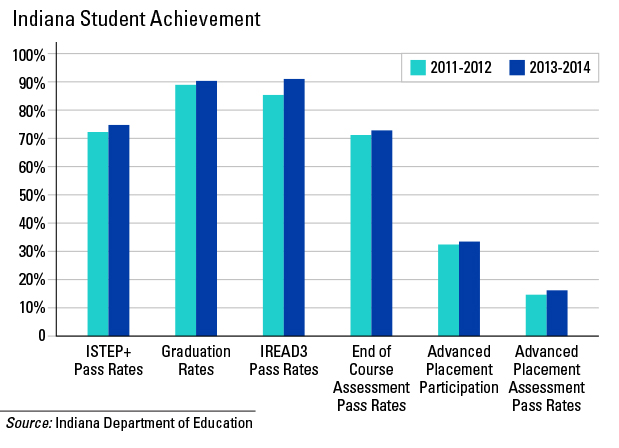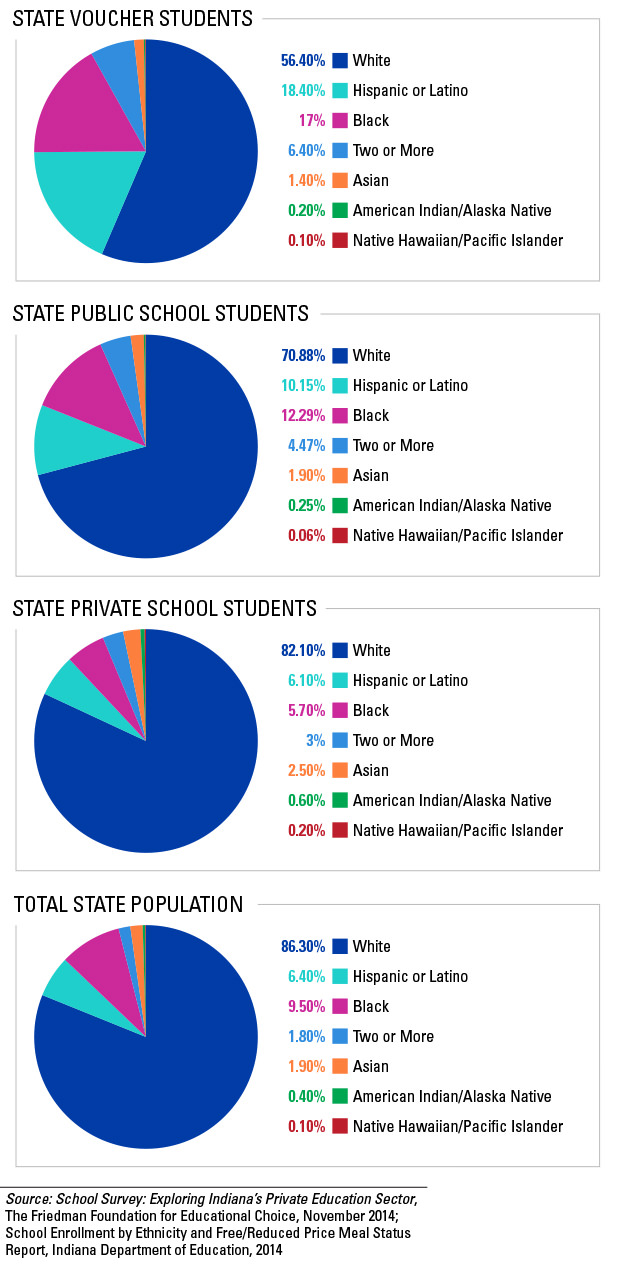Analyzing Indiana’s School Vouchers
The Center for Tax and Budget Accountability (CTBA) released a report last week on the impact of Indiana’s school choice programs, specifically its school voucher program.
To date, the dialogue around the report has focused on the CTBA’s claim that there is no evidence school choice improves student performance—an unsubstantiated conclusion reached partly by ignoring or distorting the results of high-quality research. Jason Bedrick, a Friedman Foundation fellow, documented those failings along with corrections to the organization’s fiscal analysis in detail.
Surprisingly, there are three key points that haven’t yet been discussed.
1. What does student achievement data from Indiana actually say?
The CTBA’s analysis of Indiana’s school vouchers and other programs ignored any student achievement data from Indiana.
In its report, the CTBA states:
“Indeed, based on the available evidence, rather than improve student performance and the overall public education system in Indiana, the Indiana Choice Legislation may actually impede student achievement specifically and harm the education system generally. At a time when public resources are scarce, it is not advisable for state decision makers to divert public education funding to programs that cannot be expected to help children learn or improve the education system.”
On the contrary, student achievement has steadily increased across the board since Indiana’s school vouchers, the Choice Scholarship Program, was enacted in 2011. The data below show increases in ISTEP+ pass rates, graduation rates, IREAD-3 pass rates, end-of-course assessment pass rates, Advanced Placement participation, and Advanced Placement assessment pass rates. Additionally, data from the Indiana Department of Education indicate the number of A-rated schools has increased from 856 in 2011 to 1,124 in 2014 while the number of F-rated schools has decreased from 144 in 2011 to 84 in 2014.

2. Are Indiana’s school vouchers likely to cause racial segregation in schools?
The CTBA stresses that the focus of its report was answering the question: “Can Indiana expect its school choice program to enhance student performance or help build a better public education system statewide?” The organization’s spokespeople have said they felt they were clear to readers that they were looking at school voucher programs specifically through the lens of student performance.
It’s puzzling, then, that the report made this claim with no real evidence to support its accuracy.
“Because white children as a percentage of voucher recipients in the 2014-2015 school year exceed the next largest racial group by more than 44 percentage points, Indiana’s voucher program will likely lead to increased racial stratification within Indiana’s K-12 public schools.”
White students make up 56 percent of the students receiving school vouchers in Indiana. However, white students are underrepresented among school voucher students relative to the overall student population. In fact, minority students make up a higher percentage of students enrolled in the voucher program (43 percent) compared to their representation in public schools (30 percent) and the entire K-12 student population (30 percent).
Moreover, as illustrated in the charts below, the racial composition of Indiana’s private schools closely resembles that of the total state population.

Although those charts provide context, they tell us little about the racial composition of individual public or private schools. To be fair, it is possible that some white students could be using vouchers to attend private schools that are disproportionately white relative to nearby public schools, and some school voucher students of color could be attending private schools that have a disproportionately higher percentage of minority students. But the CTBA offers no data to prove that is happening on a mass scale in Indiana.
The report also says Indiana’s school voucher program is “likely to lead to racial stratification.” There are many well-established school voucher programs across the country to which we can look to determine what is likely to happen. Several studies have investigated the impact of school choice programs on racial integration, all of which the CTBA ignored in its report. \
Seven out of eight empirical studies on the impact of school voucher programs in Cleveland, Milwaukee, and Washington, D.C., determined those programs moved students from more segregated schools to less segregated schools. One study found no visible impact. In addition, two recent studies of Louisiana’s voucher program also determined that it improved racial integration. No study ever conducted on that topic has ever found school voucher programs to increase racial segregation in schools.
3. Is it wise to rely solely on student test scores to determine whether school voucher programs should remain an option for families?
As it is now, the CTBA report treats voucher students and public school students as bundles of data, not the unique human beings they are. Few, if any, parents or teachers will say they see their children as test scores or price tags. Of course, it is important to check on the health of a school choice program, but it is reckless to use limiting metrics to condemn a program and all the families who use it.
Decisions that determine the type of educational setting children can or should be able to access shouldn’t be made based on the averages of test scores. They should be made based on a child’s individual learning needs, and that’s what the school voucher program does. It empowers parents—who are their children’s best advocates—to afford the schools and services that fit their needs. That’s something numbers in a spreadsheet can’t explain.
In the spirit of affording all families those same opportunities, Indiana is one of the states leading the nation in its expansion of school choice programs. Misinformation on the yields of such programs should not be allowed to drown out the voices of more than 29,000 Indiana families whose personal stories make the benefits of school choice indisputable.




